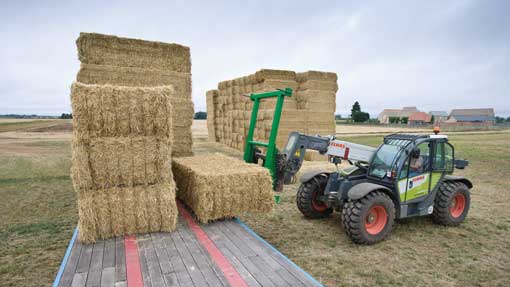Staff training brings farm business rewards

There has never been a greater need for a professional, structured approach to training in a progressive farming environment, argues health and safety expert Oliver Dale of Safety Revolution.
For all sorts of reasons, agriculture needs to take training more seriously. If it fails to do so, individual businesses and the industry as a whole will suffer.
In an increasingly competitive employment market, employees will be accustomed to shorter periods of employment linked to career progression.
Training is a great way of building mutual commitment and loyalty and creating a strong team ethos.
So it makes business sense to spend time, effort and money on training, from compliance with statutory requirements through to achieving efficiency and productivity gains.
 Oliver Dale
Oliver DaleHealth and safety expert
Safety Revolution
Building skills within a team should be viewed ultimately as an investment. Implementing a structured and professional training programme reaps benefits, including better staff retention and motivation, a safer working environment and, ultimately, a more stable, productive and profitable team.
As a new generation of more technically savvy employees enters agriculture and related sectors over the next 10 years, we will see a major shift in their training needs and expectations.
These new entrants will be more mobile, more career-minded and will have a greater expectation of their employers, including a belief that training will be integrated within their roles and a basic part of their continuous professional development (CPD).
Health and safety law requires that training and refresher sessions are routinely provided. The objective from the Health and Safety Executive (HSE) perspective is to reduce the likelihood of an accident occurring through the provision of practical training that helps staff understand how to operate plant and equipment safely.
The guidance issued by the HSE lays out what employers are expected to do. Quite often the fact that it is presented as “guidance” leads people to think that there is some leeway in whether or not it should be applied.
Trainer shortages
The reluctance of many farming businesses to take training seriously is resulting in a shortage of trainers in some disciplines. If the demand is not there, the trainers will not be available and this is already being felt in some areas.
For example, while agriculture will pay a trainer a day rate of about £150-200, the building and other trades will typically pay £300-400 a day, which is drawing trainers away from the farming pool.
Telehandler, quad bike and chainsaw training are three key areas where farming businesses often struggle to recruit trainers.
In short, you should follow that guidance. If you do not, you then have to justify why you haven’t, which is very difficult to do and leaves you potentially exposed to enforcement action.
Take telehandlers as an example. All operators must be ticketed for the equipment they are using and should have refresher training every three years. Be careful to ensure that your operators are ticketed for the correct specification of equipment – particularly in relation to the length and reach of the boom.
There are many other areas and pieces of equipment commonly used on a farm where the same or similar guidance and principles apply.
So how can employers ensure that training needs are not inadvertently overlooked and provide adequate, efficiently managed training without it becoming too costly and time-consuming?
A good formal induction is the foundation. This provides the opportunity to gather copies of new employees’ existing training records and assess any further training needs and timing.
It’s easy to document all of that using a simple induction form and a spreadsheet checklist to ensure you cover everything and as evidence you have a formal approach to training and planning.
A key requirement in relation to safety is that you prioritise training based on the level of risk inherent in the activities for which you are providing training.
If your resources are limited and you can’t afford to complete all of the required training, it’s vital that you are investing in training where the risks are highest.
Training rewarded after initial doubts
Intensive vegetable grower Ross Forster of TD Forster was keen to present a professional image for the business, demonstrating commitment to the safety and the welfare of individual members of staff.
A long list of training, all of which was a legal requirement, followed our first visit to his business based in north-east Fife.
His initial response to our assessment of training needs was fairly typical. His first concern was cost but having completed the majority of the training he is a lot more comfortable about it and thinks staff have appreciated the new approach and understand the importance of training
The greatest need on farms is for first-aid training. It is sensible for all staff to be proficient first-aiders. There is so much lone working in farming that if there is only one first-aider, then any injured member of staff is likely to be far away from that person.
This is also a good example of where farming businesses need to interpret the regulation and think what is best for the team in terms of the number of first-aiders.
People are often nervous of being responsible for first-aid but it is just that – a first response until a professional can get there.
Training needs
Identifying training needs should happen through discussion with each team member. An annual appraisal is an ideal time to do that, discussing progress and finding out what each employee feels his or her training needs are.
Often a common theme within the team will guide decision making. If a number of staff require the same training, this can help keep costs down. Also, consider collaborating with neighbours on training, again to reduce the cost.
You may also have a duty to provide training for self-employed staff or contractors.
Where a person is classified as self-employed for the purposes of tax, they are likely to be regarded as an employee for the purposes of safety-related training and you must treat them as such.
The same principle applies to contractors operating as a small business with fewer than five employees.
This is particularly true if they spend a significant proportion of their time working for you, or where they undertake one particular type of task that would be regarded as potentially high risk, such as working at height, on roofs or using ladders, platforms or harnesses.
Rather than chasing them around for evidence that they are trained, the responsible course of action is to provide that training and thereby strengthen your relationship with them in a cost-effective manner.
You may also be able to agree a financial contribution from them if they are using the skills learned with you in their work elsewhere.
When selecting formal trainers, make sure that they can provide high-quality training that motivates and engages the team.
If the trainee feels that the trainer has credibility and direct experience of the farming environment within which they work, the training is more likely to be effective and to be retained by the trainee.
Obtaining references is a good way of assessing training providers. It’s also extremely important to ensure that your trainer is properly qualified to deliver that training. Ask for copies of their training qualifications as evidence that you have properly assessed their competence – if you’re not sure how to judge that competence, ask your safety adviser to help make those checks.
A lot of training can be delivered less formally and does not have to be a classroom exercise – in fact it is far better if it is not.
Providing that you or the trainer are qualified by experience and feel confident to deliver that information, there is no reason not to provide informal training.
Also involve your safety adviser to help you assess in-house competence to deliver training.
The best environment in which to train staff is one where they feel most comfortable, relaxed and receptive.
Keeping informal training sessions short and to the point is good – half an hour or even 10 minutes of information that sinks in, is repeated regularly and influences their behaviour, is best.
If focused on quieter periods of the year or early in the day when the brain is more naturally receptive, this can help too. It is good practice to keep a record of that training.
That can be a diary note or, where you are summarising verbal instructions into a safe working practice, ask those attending to sign and date to register their attendance.
It is important to create a feeling that you take individual development seriously and that employees will continue to grow and learn with you as the business evolves.
Training checklist
- Consider not just legal requirements for training but what is best for the business – training is an important management tool, not simply an obligation
- Use a formal induction session to record training completed and assess further needs, or use a simple form and checklist instead
- Adopt a risk-based approach – train for the highest risks first if you can’t afford all training at once
- Use annual appraisals to check, record and assess further training needs
- A planned approach will ensure best value from training – allows better organisation so more than one employee can be trained at a time
- Make sure training is relevant to exactly the type of equipment being used
- Be aware that training of self-employed people and contractor staff may be your responsibility even if they are not on your payroll
- Choose trainers carefully – do they have direct experience of the tasks for which they are training and are they appropriately qualified?
- Informal training is acceptable – do you or other employees have skills to pass on?
- Plan training – don’t rush it; choose a suitable time (ideally not at the end of the day)
- Keep a record of all training – ask employees to sign at the end of each training course/session
